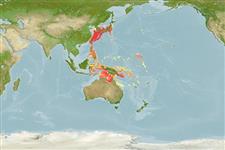Elasmobranchii (sharks and rays) >
Carcharhiniformes (Ground sharks) >
Triakidae (Houndsharks) > Galeorhininae
Etymology: Hemitriakis: hemi-, from hemisys (Gr.), half, being a genus that Herre believed was “most closely related” to Triakis. (See ETYFish); japanica: -ica (L.), belonging to: Japan, type locality. (See ETYFish).
More on authors: Müller & Henle.
Environment: milieu / climate zone / depth range / distribution range
Ecology
Marine; demersal; depth range 20 - 345 m (Ref. 86942). Subtropical; 40°N - 19°N, 112°E - 141°E
Northwest Pacific: China, Taiwan, Korea, and Japan. Nominal records from Ambon, Indonesia (unconfirmed and based on a specimen close to if not identical to Hemitriakis abdita) and New Caledonia (Ref. 13563).
Length at first maturity / Size / Weight / Age
Maturity: Lm 91.5, range 81 - 102 cm
Max length : 110 cm TL male/unsexed; (Ref. 244); 120.0 cm TL (female); max. reported age: 15 years (Ref. 9031)
Occurs close inshore and offshore down to at least 100 m depth. Presumably feeds on small fishes, cephalopods and crustaceans. Ovoviviparous, with 8 to 22 young in a litter. Size at birth about 20 to 21 cm. Utilized for human consumption.
Ovoviviparous, embryos feed solely on yolk (Ref. 50449).
Compagno, L.J.V., 1984. FAO Species Catalogue. Vol. 4. Sharks of the world. An annotated and illustrated catalogue of shark species known to date. Part 2 - Carcharhiniformes. FAO Fish. Synop. 125(4/2):251-655. Rome: FAO. (Ref. 244)
IUCN Red List Status (Ref. 130435)
Threat to humans
Harmless
Human uses
Fisheries: commercial
More information
Age/SizeGrowthLength-weightLength-lengthLength-frequenciesMorphometricsMorphologyLarvaeLarval dynamicsRecruitmentAbundanceBRUVS
ReferencesAquacultureAquaculture profileStrainsGeneticsElectrophoresesHeritabilityDiseasesProcessingNutrientsMass conversion
Tools
Warning: mysqli::__construct(): (HY000/1040): Too many connections in /var/www/html/includes/speciessummary.lib.php on line 2414
Can't connect to MySQL database fbquizv2. Errorcode: Too many connections
